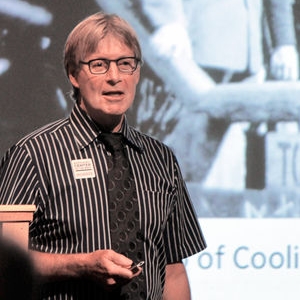
Ross A. Eaman
Adjunct Research Professor
| Department: | School of Journalism and Communication |
| Degrees: | B.A. (Carleton), M.A. (Toronto), Ph.D. (Queen's) |
Biography
Ross A. Eaman received an Honours B.A. from Carleton University, an M.A. from the University of Toronto, and, with the support of a Canada Council doctoral fellowship, a Ph.D. from Queen’s University, all in history – with the latter degree including a thesis on the intellectual history of morality as a force in history.
Upon joining the faculty of the School of Journalism (later Journalism and Communication) at Carleton, he undertook two major research major projects in conjunction with its new undergraduate program on mass communication: the writing of a specifically Canadian textbook on the mass media –The Media Society: Basic Issues and Controversies (Butterworths, 1987); and direction of a CBC Oral History Project sponsored by the National Archives of Canada, the Canadian Broadcasting Corporation, and the School of Canadian Studies at Carleton. With the further support of two SSHRC grants, the latter project conducted interviews across the country using graduate students in Canadian Studies as an archival resource for future research. It contributed to Ross’s own publications on the CBC, beginning with Channels of Influence: CBC Audience Research and the Canadian Public (University of Toronto Press, 1994) and continuing, more recently, with “‘The Story is Only the Platter on Which the Personality is Served’: The Debate Over Media Integrity on CBC Radio’s Literary Arts Programming, 1948-1985,” Canadian Journal of Communication 40, no. 3 (2015), 519-36. It also informed his original article on “CBC/Radio-Canada” for the Canadian Encyclopedia, which has recently been updated by Sasha Yusufali and Sharon J. Riley; entries such as “Bureau of Measurement” and “Wayne and Shuster” for the Encyclopedia of Television; evidence presented in person to the Standing Committee on Canadian Heritage related to “saving the CBC”; and input as a member of the advisory committee for the Auditor General’s Special Examination of the CBC, for which he developed a method of assessing the relative distinctiveness of CBC English TV programming.
In the early 2000s, Ross was invited to write as sole author an encyclopedic guide to journalism from the acta diurna in ancient Rome to the present day. The result was the first edition of the Historical Dictionary of Journalism (Rowman and Littlefield, 2009) – No. 4 in the American publisher’s Historical Dictionaries of Professions and Industries series. It has since been updated and substantially expanded with the help of colleague Randy Boswell as Historical Dictionary of Journalism (rev. ed., 2021), 520 pp., available online for the Carleton community through the MacOdrum Library and featuring an introductory history of journalism as an evolving form of discourse.
In addition to writing reviews such as “The Neo-University,” Topia: Canadian Journal of Cultural Studies, no. 28 (Fall 2012), 245-50, Ross has been a regular participant at the annual conference of the Canadian Communication Association, his presentations including “Media History and the Problem of Periodization” (Montreal, 2010), “Emerson, James, and Rorty on Communication and Moral Progress” (Kitchener-Waterloo, 2012), “Mapping the Universe of Discursive Sites: A Burkean-Based Cartography” (St. Catharines, 2014), “How Do Buildings Mean? A New Approach to Communication and the Built Environment” (Ottawa, 2015), and “Selling Modern Architecture through Film: The Mechanical Rhetoric of the National Film Board” (Ryerson, 2017).
As the latter presentations indicate, Ross’s research and teaching shifted during the 2010s to the new topic of communication and what some anthropologists had begun calling the built environment. Over the course of several summers, he travelled to Custer State Park, Yellowstone National Park, and Yosemite National Park to conduct on-site research on parks from this perspective. Some of this research was combined with his teaching on discourse analysis and presented as Five Speeches, Five Eras: Presidential Perspectives on Yellowstone, a public talk at the Buffalo Bill Center of the West in Cody, Wyoming, on August 12, 2014 (photograph above courtesy of Raymond Hillegas, Cody Enterprise).
Designing “wilderness” in national parks is only one aspect of how built environments function as a medium of communication. In broadening his research and teaching to include built structures and spaces generally, it became evident to Ross that their meaning is communicated in a manner that is sui generis or unlike that of conventional media. This, at least, is the thesis of his forthcoming publication Architecture as Communication: A Medium Like No Other (McGill-Queen’s University Press, April 2025).